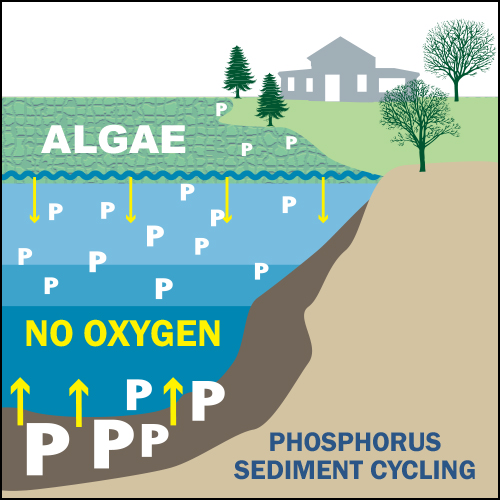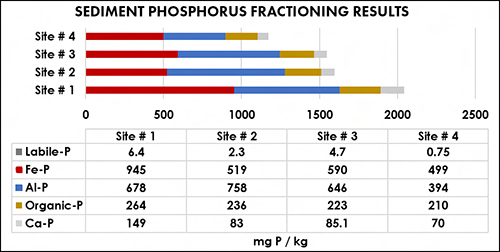Are Lake and Pond Sediments Causing Algae Blooms?
The sediments in your pond or lake may be the cause of recurring or toxic algae blooms. We all know these blooms are a major source of frustration for property owners and those who manage them. Phosphorus is the nutrient that feeds these blooms, but it is not always obvious where the phosphorus is coming from. You have probably dealt with known surface sources already. If you still have problems, the next place to look is the bottom sediment.
Internal phosphorus (P) recycling from lake and pond sediments can be the driving force behind poor water quality and cyanobacteria blooms. Understanding when, where, and how much internal P recycling is occurring in your lake is key to addressing water quality and reducing cyanobacteria blooms.
This information, paired with external P load estimates, provides the foundation for developing a P budget and water quality model to determine how restoration efforts will impact water quality.
Understanding Internal Phosphorus Re-cycling
 The process of internal P recycling from lake and pond sediments are complex and influenced by many factors including:
The process of internal P recycling from lake and pond sediments are complex and influenced by many factors including:
- Biological – examples include bacterial activity, mineralization
processes, and bioturbation - Chemical mixing
- Sediment mixing
In general, the distribution of organic matter or “muck” is where most of the internal P recycling occurs. A newly formed lake will not have much organic matter, and rates of internal P recycling will be low.
However, as waterbodies age and organic matter is deposited over time, the rates of internal P recycling increase. The older the lake, the more internal P recycling and the greater risk of cyanobacteria blooms and poor water quality.
Quantifying Pond Sediments Phosphorus Re-cycling
Estimating the amount of internal P recycling occurring per sediment area and under different conditions can be done in a variety of ways. One cost-effective and accurate way is to collect surficial sediments. We take these from the “active” P layer of sediment (typically the top 10 cm or 4 inches of sediment). This allows us to determine the amount of P bound to different forms in sediment.
 Total phosphorus values >500 mg/kg are considered high. But, the availability of that phosphorus cannot be known from total P concentrations.
Total phosphorus values >500 mg/kg are considered high. But, the availability of that phosphorus cannot be known from total P concentrations.
Sediment P fractioning will provide a direct estimate of P release under different conditions. For example, the amount of iron-bound P can provide estimates of P release once oxygen has been depleted. Each form of sediment-bound P is important in understanding internal P re-cycling and how to manage it.
Managing Internal Phosphorus Recycling
Once you have a good understanding of internal P recycling from pond sediments, you can take steps to manage it properly. Some common management strategies to address internal P recycling are provided below.
- Aeration/oxygenation – Restoring deep water oxygen can greatly reduce iron bound P loading, and likely shift the algal community to a more desirable one.
- Phosphorus Inactivation
- Dredging
Consult with one of our experts today.
Vertex Aquatic Solutions, founded in 1977, is the professionals’ choice for research based scientific consulting services, aeration systems, floating fountains, bubble curtains and biological products to enhance water quality in lakes, ponds, canals, marinas and reservoirs. As respected leaders in the lake management industry the Vertex team of aquatic biologists, limnologists, fisheries scientists and engineers work together to deliver science-based, environmentally sound solutions to complex waterbody issues. Our products and services are delivered through an international network of qualified, experienced waterbody professionals who provide local support, service and pond management expertise to customers.
← Previous